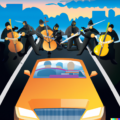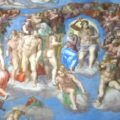 Roger L. Bagula wrote this exclusive article for ManuelMarino.com.
Roger L. Bagula wrote this exclusive article for ManuelMarino.com.
In a time when the whole future of how music is distributed is in question, maybe we should look at the history of music for a guide. Many of us find music is a part of our everyday life; both in terms of listening and making it. I have an egroup on the archaeology of prehistoric men. Music seems to have been part of what distinguishes men for other beats. The discovery of a bone hollowed out to make a flute by Neanderthals has made many speculate that music is one of the oldest “preoccupations” that didn’t actually produce survival rewards.
We picture men with low foreheads sitting around the campfire playing bone flutes and beating on hollow logs. The man who was good on the flute had to be subsidized by the other hunters. In the Sahara Arab culture the women are the make the music. There are ancient Egyptian Ancient Egyptian Clothes - Ancient Egyptian Clothes: the ancient Egyptians, both men and women, wore linen clothing to cope with the hot weather. Men donned short skirts called kilts, while women wore form-fitting dresses with shoulder straps. Wealthy men sported pleated kilts, and older men wore longer ones. For labor, men wore loincloths and women wore short skirts. Children… drawing of people playing stringed instruments, The god Mot is said to have had music in his temples. The ancient Greeks had a very well developed theory of 5 tone music as well.
In the European tradition what is called “church music” was actually scripted in a staff in 8 tones during the medieval era. In both church and secular life music was an everyday entertainment and some people spent their lives as singers in the Jewish Cantor tradition. At this time a distinction between “holy” and profane (dance) music seems to have been made.
The age of reason gave us Bach fugues and well tempered music with twelve major tones instead of just 8. Keyboard instruments appeared in churches and the drawing rooms of the rich and famous. Europe was a center of world culture in the arts and sciences with university courses being taught in music theory.
Revolt against this almost always pleasant sounding music turned up in the form of Schönberg and his ideas of twelve tone sequences. Others experimented with expressionism and what they called “tone color” in trying to match the music and art of a puzzling modern world.
But little known to the European intellectuals a new music form came to life in America based on a African folk form and being fostered by the black community quite by itself. Jazz was a free form music where chord forms called progressions were used and many of the people playing the music couldn’t read sheet music How To Read Piano Piece Music Fast - Learning to play the piano and read sheet music doesn't have to be intimidating. You don't need an exceptionally high IQ for this; all you need is perseverance and consistent practice, along with an easy-to-read piano sheet. By following some guidelines, learning can become easier. Here are some tips to help you as you gradually… at all. It involved syncopation, drums and rhythm fugues as well as multi-melodies in an ad lib setting. It was involved in moods as the blues and dance in terms of swing and jitter-bug and was considered profane in many white communities. Until recording and radio it was pretty much played for free in clubs where blacks went at night . But even as simple as the chord progression were it displaced classical forms in the hearts of most of the world’s population in less than 50 years form Rag time in 1900 to the 1950’s Rock and Roll. In the materialistic society success came with money and records by these artists sold so well that they became the new rich of the 20th century.
In the ’60’s I met a black sargent (hard stiriper) in Army who did this odd kind of poetic singing that he called rap. We all scorned him because we knew that Rock and Roll was king and it was here to stay. Again out of the sub-community of the black in a America and off shot of funk music used as backing for this rap singing came out of seeming nowhere in the 90’s to become a real musical movement world wide. The poor black was angry: he had been promised “equal rights”, but he got welfare and lingering on street corners while dope dealers preyed on him and his community.
Urban renewal meant that he was shoved out of his generational neighborhoods so that up town whites could have new condos closer to work. Gangs took control of streets and whole communities and had shooting wars while the mostly white police forces hid in their substations until the shooting stopped. As far as I know there has been little reform in response to this widely popular music style What's the Most Readily Useful Electric Guitar For Guitar Lessons? - There are several variations, but primarily three types of guitars to consider when starting guitar lessons: Classical Acoustic, Acoustic, and Electric. Many beginners start guitar lessons with a classical acoustic or steel-string guitar. These are the most common types available for borrowing, and it's less likely you'll be loaned a more complex guitar. Learning on… and the angry and profane words involved.
Another trend in music has been multi-tonality. Everyone knows listening to a slide trombone that there are an infinite scale of notes possible to music. Mostly we think in terms of a scale based on powers of two. The twelve tone scale came about when the Greek pentatonic scale was rationalized with the church 8 tone scale. Adding an C flat and an F flat (or two more sharps) seems to even out the keyboard in 14 tones instead of 12. The Arab musical intellectuals who were influenced by ancient Indian musical theory added twelve “between” tones and special Indian like tuning forms. To western ears Indian and Arab music has a unique blue or “color tonal” feel to it that is attractive to a mind tired out by a limited tone scale of 12 tones.
In the early 20th century an electronic instrument called a Theremin was invented using the electronics that came with shortwave and AM radio. This instrument involved producing tones of all kinds of sine waves. By the 50’s this kind of music found it’s way into science fiction Early Science Fiction On The Airwaves - Science Fiction in Radio Some might argue that Science Fiction has existed as long as civilization itself, as people gazed at the stars and wondered, "what if…" Juvenile Serials from the 1930s The first scifi old-time radio shows were primarily adventure serials aimed at young audiences, featuring a scientific theme, most notably Buck Rogers and… classics as Alien music.
In the 60’s with the use of computers the digital slicing and dicing of sound had started. The result as we all know is the compressed digital sound file called the mp3, but electronic music Trance Music - Free Flowing Electronica - Have you ever found yourself dancing in a club, utterly absorbed in the melody, feeling as if the trance music is flowing through you and guiding your body's movements? This is an experience I've had numerous times during carefree nights at local techno clubs I've often wondered which type of techno generates this unforgettable sensation… had become more than this ! From digital midi sequencing and interfaces that captured keyboard notes as score notes on an electronic staff to distortion electronics that could make a guitar sound Ibanez Acoustic Guitars - Ibanez acoustic guitars are among the leading guitar brands in the market. These guitars are incredibly versatile and cater to a wide range of music genres. With so many guitar brands available, it can be challenging to choose just one. However, the Ibanez guitar stands out for its robust qualities and exceptional sound. About Ibanez… completely different with feedback and reverberation effects, new music that had never been heard by human ears before was being invented and circulated. Like rap music, it wasn’t at first very easy to get such music to the mass audience, but the European “House” dance music of night clubs began to change that in the 80’s. Here a century long decline in European music began to turn around, so that the German school of electronic music is a leader in innovation and Americans seem to be trailing behind?
The conversion of the CD digital formate files (Aiff and wave) to mp3 in the 90′s by Classic Mac SoundJam which was taken over by Mac and called iTunes made upload of digital files to the Internet The World-wide-web Niche - The global economy has been severely impacted. Millions of people have lost their jobs, many are losing their homes, and retirement portfolios are disappearing at an alarming rate. What happens in the World Wide Web? We often discuss the global financial tsunami, an economic crisis on a scale that rivals the Great Depression of the… easy. People began to share their favorite music internationally. Downloads of digital music The Evolution of Music and the Digital Era: A Personal Journey - As we stand at the crossroads of technological innovation and creative expression, I find myself reflecting on my journey in the music industry—a journey that began in the late '90s, a pivotal era that marked the beginning of a digital music revolution. It was a time when mp3.com emerged as a groundbreaking platform, offering independent… on inexpensive laptops, even at several megabytes each became very common.
The recording Industry being on the back end of this movement and historically behind in the innovation curve was caught unprepared. They began suing private citizens (college students who are the poor). For the rich to be openly prosecuting the poor for the crime of “downloading” became the democratically most unpopular move in ages.
It is the royalty money from the sale of recoded media that has made the new music rich like the Beetles. The failure of recording industry executives to find a way to plug this hole in revenues seems to signal a decline in such music as a way of passing music around that has been popular since the 1920’s and AM radio started it off. Before that it was sheet music that passed the music from one place to another.
The result of this crisis is that we are faced with a change in how music is given to the public. From my own experiences the recording industry corporate model hasn’t been a perfect one. We are looking at an art form where their are several kinds of artists who need to support their families: composers, performers and song lyrics writers. If these people “suffer”, then the listeners will be affected shortly after in not being able to get music that they want.
Survival and eating are usually a little above making music on the daily calendar.
Manuel Marino is a seasoned Senior Producer, Music Composer, and Artist with over a decade of experience. He specializes in branded entertainment across various mediums, including video games, films, and advertising campaigns. With 20+ years as a game music composer, Manuel has worked on numerous platforms, creating diverse orchestral soundtracks. HIRE ME


 Manuel is a passionate, driven, and techsavvy AV technician,
Manuel is a passionate, driven, and techsavvy AV technician, 










Hi Music is good art.
———–
Sareja
Great article! I am a firm believer in embracing new technologies and ideas to get the music out there.
While bringing new technology is good in the music world, unfortunately today’s music is garbage because they computerize and overgeneralize music. The musicality is gone especially in pop music
technology has made it too easy to make music, theres a over saturation and more doesn’t always mean better.
Why would you say music is garbage… well, probably the most lyrics of today’s songs have really gone beyond the usual err tradition, whatever you call it. But technology has helped so much in the evolution of creating more unique songs. Take for example, I am a drummer. When I first started, it was the usual set of drums, and you can never play a good song by your one. With todays technology, you can easily incorporate a midi player or some digital pads and be a complete band by yourself which was totally impossible in the old times.
technology helped a lot but standardized a lot as well. I can say that every decade has its own pros and cons. “standard” doesn’t mean bad, anyway. Let’s think about synth pop, it’s a standard, but I absolutely love it and many top songs of all times are from there.
hmm interesting post, i appreciate you taking us through the timeline of music! Interesting how technology was able to open up new ways of hearing music!
A very informative article. i really learnt a lot from the breakdown of the history and growth of music int the world. Thanks for sharing this .